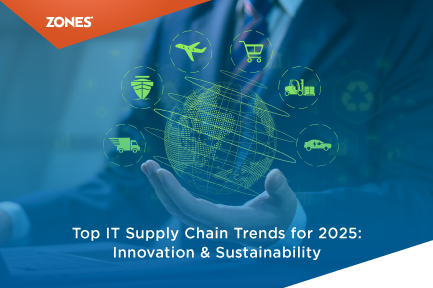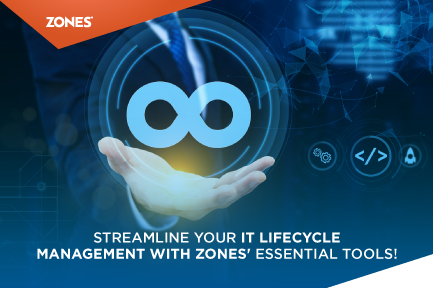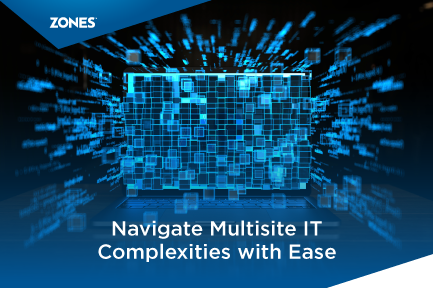9 IT Rollout & Tech Implementation Trends for Multisite Businesses
The landscape of IT enablement and technology implementation across distributed locations continues to evolve rapidly. Organizations are increasingly...
5 min read
George Ganas : Feb 10, 2025 1:33:20 PM

The evolution of the enterprise IT supply chain tells a compelling story of adaptation and innovation. A decade ago, organizations typically managed hardware through disconnected processes—procurement teams placed orders, logistics handled shipping, and IT managed deployment. This siloed approach worked in a simpler business environment, but today's global operations demand something far more sophisticated.
The transformation began with the digitization of fundamental processes, followed by the integration of different supply chain functions. However, the real revolution came with the emergence of intelligent, predictive systems that could anticipate needs, automate decisions, and optimize operations across global networks. The pandemic accelerated this evolution, forcing organizations to rethink their approach to hardware management and embrace more flexible, resilient supply chain models.
As we progress through 2025, the enterprise IT supply chain is undergoing a fundamental transformation driven by several converging forces: the permanence of hybrid work models, the need for supply chain resilience in an uncertain world, the imperative for sustainable operations, and the demand for seamless global hardware management.
This new landscape is characterized by interconnected regional networks, proactive asset management, dynamic workplaces, and integrated processes. Organizations are moving away from traditional transactional relationships with vendors toward strategic partnerships that encompass the entire hardware lifecycle.
The hybrid workplace has revolutionized device deployment models. Organizations are implementing sophisticated direct-to-employee fulfillment systems that can deliver and configure devices anywhere in the world. This includes pre-configured hardware shipping directly to home offices, automated device setup processes, and remote support capabilities. For example, when onboarding new employees, companies can now ship fully configured devices to any location, complete with local language settings, security protocols, and workplace applications – all without IT personnel ever touching the device.
With ongoing geopolitical tensions affecting manufacturing and trade, employees spread across regions; organizations will establish diverse supply chain networks across multiple regions to ensure continuous hardware availability. Companies will maintain strategic partnerships with OEMs and configuration centers across multiple regions, enabling them to quickly deploy or replace devices. This approach will provide resilience against regional disruptions while reducing dependency on centralized distribution, ensuring consistent device standards across all work locations.
| Watch Webinar: Mastering Global IT Supply Chain in a Multisite Setup |
Organizations will move beyond traditional vendor relationships toward strategic ecosystem models. While diversifying OEM partnerships to ensure hardware availability and risk mitigation, companies will simultaneously consolidate their vendor base to work with fewer, more capable strategic partners. These partners will likely deliver comprehensive services across multiple locations, with guaranteed service levels for device availability, deployment times, and support across global operations. This balanced approach will enable businesses to maintain device diversity and competitive pricing while reducing the complexity of vendor management.
As trade regulations evolve and supply routes shift, organizations are likely to establish integrated cross-border operations with regional distribution hubs serving multiple countries. These networks will feature automated customs documentation systems and flexible routes to navigate changing trade landscapes. Distribution systems will dynamically adjust patterns based on multiple factors: local demand, shipping constraints, regulatory requirements, and sustainability goals, ensuring efficient hardware movement across global operations.
The traditional centralized inventory approach will give way to location-optimized models. Organizations will adopt hybrid inventory systems where trusted partners manage optimal stock levels across different locations based on local business needs, lead times, and regulatory requirements. This evolution will combine strategic buffer stocks with dynamic inventory management, ensuring business continuity while optimizing costs. Partners will take increasing responsibility for maintaining appropriate stock levels, reducing the operational burden on organizations while ensuring consistent device availability.
Managing hardware returns and asset disposal processes will evolve into a strategic business function. Organizations will implement sophisticated reverse logistics programs that combine efficient device retrieval, secure data management, and value recovery. These programs will integrate coordinated device collection across global locations, secure data wiping, refurbishment operations, and either redeployment or responsible disposal. The focus will shift from simple disposal to maximizing value recovery while ensuring environmental compliance and data security.
Environmental considerations will become central to IT supply chain decisions. Organizations will implement comprehensive sustainability programs encompassing eco-friendly packaging, carbon-optimized shipping routes, and device lifecycle extension initiatives. The adoption of circular economy principles will accelerate, with organizations focusing on maximizing device lifespan through refurbishment programs and responsible disposal practices. Carbon footprint metrics will become key performance indicators in supply chain operations.
With regulations continuing to evolve across regions, organizations will build dynamic compliance networks. These systems will automatically adjust hardware specifications, shipping routes, and documentation requirements based on current regional regulations. Real-time monitoring and automated compliance verification will become standard practice, ensuring continuous adherence to varying regulatory requirements across global operations.
Support models will evolve to address the needs of permanently distributed workforces. Organizations will implement location-agnostic support systems capable of efficiently handling device issues regardless of employee location. This will include advanced exchange programs for remote workers, global repair network access, and innovative approaches to device replacement that minimize employee downtime while maintaining security and compliance standards.
Hardware management will shift toward comprehensive lifecycle-as-a-service models. Rather than managing individual processes, organizations will adopt integrated solutions that handle everything from procurement to disposal. These models include automated refresh cycles, proactive maintenance, and built-in sustainability practices. This approach will ensure consistent device management across all work locations while optimizing costs and reducing administrative burden.
In this complex landscape, Zones has emerged as a crucial partner for enterprises seeking to optimize their IT supply chain operations. Through its comprehensive Global Supply Chain as a Service (GSCaaS) offering, Zones delivers end-to-end solutions that address the entire spectrum of modern IT supply chain challenges.
Additionally, with Zones IntelliPlanSM, our smart inventory management solution, you can harness the power of advanced demand planning and forecasting to ensure on-time and precise rollouts. IntelliPlanSM enables centralized visibility into project progress, timelines, and resource allocation.
Being recognized by ISG for Supply Chain Services, Zones brings deep industry expertise with advanced technology platforms to create a seamless, efficient, and sustainable IT supply chain ecosystem. The company's strategic partnerships with significant OEMs ensure access to genuine products, while its global network of Technology Solution Centers provides the local support necessary for effective implementation.

Learn tips & tricks on how to use the all-new Content Slider module here. Have feedback on an awesome feature we should add to this module or discover a bug? Pop right over here to submit your ideas.
As organizations continue to expand globally and adapt to changing business requirements, efficient IT supply chain management becomes increasingly critical to success. Success requires moving beyond traditional supply chain thinking to embrace more dynamic, integrated approaches. The future belongs to organizations that embrace these trends and partner with providers who can deliver comprehensive, integrated solutions.
Ready to transform your IT supply chain for the digital age?
Contact Zones to discover how our global IT supply chain services can modernize your hardware management operations and drive operational excellence.

The landscape of IT enablement and technology implementation across distributed locations continues to evolve rapidly. Organizations are increasingly...

Today, managing IT assets throughout their lifecycle has become a critical challenge for businesses of all sizes. Each stage of an IT asset's...

Today, accelerating globalization, market demands, and competition drive companies' expansion and utilization of multiple offices across cities,...